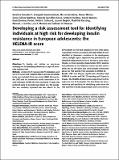Por favor, use este identificador para citar o enlazar a este item:
http://hdl.handle.net/10261/297218COMPARTIR / EXPORTAR:
 SHARE SHARE
 CORE
BASE CORE
BASE
|
|
| Visualizar otros formatos: MARC | Dublin Core | RDF | ORE | MODS | METS | DIDL | DATACITE | |

| Título: | Developing a risk assessment tool for identifying individuals at high risk for developing insulin resistance in European adolescents: The HELENA-IR score |
Autor: | Kondakis, Katerina; Grammatikaki, Evangelia; Kondakis, Marios; Molnár, Dénes; Gómez-Martínez, Sonia CSIC ORCID; González-Gross, Marcela CSIC ORCID; Kafatos, Anthony; Manios, Yannis; Jiménez-Pavón, David; Gottrand, Frederic; Béghin, Laurent; Kersting, Mathilde; Castillo, Manuel J.; Moreno, Luis A.; De Henauw, Stefaan | Palabras clave: | Adolescents VO2max Body fatness Type 2 diabetes Insulin resistance Screening tool |
Fecha de publicación: | 2022 | Editor: | Walter de Gruyter | Citación: | Journal of Pediatric Endocrinology and Metabolism 35(12): 1518-1527 (2022) | Resumen: | [Objectives] To develop and validate an easy-to-use screening tool for identifying adolescents at high-risk for insulin resistance (IR). [Methods] Α total of 1,053 adolescents (554 females), aged 12.5 to 17.5 years with complete data on glucose and insulin levels were included. Body mass index (BMI), fat mass index (FMI) and the homeostasis model assessment for insulin resistance (HOMA-IR) were calculated. VO2max was predicted using 20 m multi-stage fitness test. The population was randomly separated into two cohorts for the development (n=702) and validation (n=351) of the index, respectively. Factors associated with high HOMA-IR were identified by Spearman correlation in the development cohort; multiple logistic regression was performed for all identified independent factors to develop a score index. Finally, receiver operating characteristic (ROC) analysis was performed in the validation cohort and was used to define the cut-off values that could identify adolescents above the 75th and the 95th percentile for HOMA-IR. [Results] BMI and VO2max significantly identified high HOMA-IR in males; and FMI, TV watching and VO2max in females. The HELENA-IR index scores range from 0 to 29 for males and 0 to 43 for females. The Area Under the Curve, sensitivity and specificity for identifying males above the 75th and 95th of HOMA-IR percentiles were 0.635 (95%CI: 0.542–0.725), 0.513 and 0.735, and 0.714 (95%CI: 0.499–0.728), 0.625 and 0.905, respectively. For females, the corresponding values were 0.632 (95%CI: 0.538–0.725), 0.568 and 0.652, and 0.708 (95%CI: 0.559–0.725), 0.667 and 0.617, respectively. Simple algorithms were created using the index cut-off scores. [Conclusions] Paediatricians or physical education teachers can use easy-to-obtain and non-invasive measures to apply the HELENA-IR score and identify adolescents at high risk for IR, who should be referred for further tests. |
Versión del editor: | https://doi.org/10.1515/jpem-2022-0265 | URI: | http://hdl.handle.net/10261/297218 | DOI: | 10.1515/jpem-2022-0265 | E-ISSN: | 2191-0251 |
| Aparece en las colecciones: | (ICTAN) Artículos |
Ficheros en este ítem:
| Fichero | Descripción | Tamaño | Formato | |
|---|---|---|---|---|
| develophelena.pdf | 580 kB | Adobe PDF |  Visualizar/Abrir |
CORE Recommender
Page view(s)
41
checked on 28-abr-2024
Download(s)
14
checked on 28-abr-2024
Google ScholarTM
Check
Altmetric
Altmetric
NOTA: Los ítems de Digital.CSIC están protegidos por copyright, con todos los derechos reservados, a menos que se indique lo contrario.
